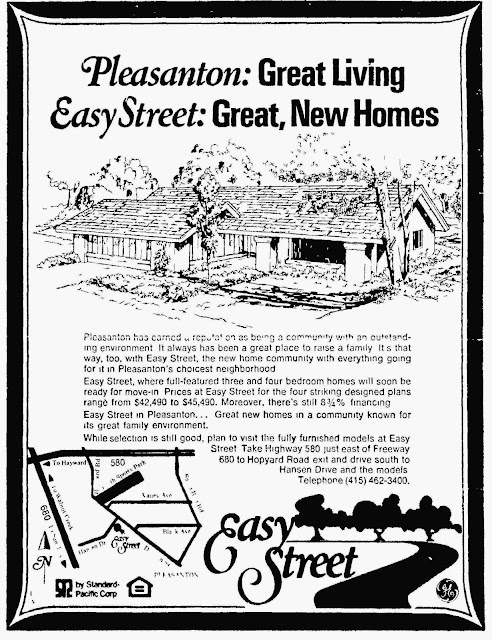Easy Street and Pleasant Meadows: a quiet corner of Del Prado (1972—1976)
As an infill project within Pleasanton’s larger Del Prado neighborhood, Standard-Pacific Corporation built a collection of 3- and 4-bedroom homes under the name Easy Street. Though technically part of Del Prado, Standard-Pacific never used the name to market the development—likely because Del Prado was already synonymous with founding builders Ditz-Crane and Mackay, and had a strong local reputation.
 |
| Location of the Del Prado neighborhood in Pleasanton, California. As an in-fill development, Easy Street was built between Mackay and Ditz-Crane homes. |
From Easy Street to Pleasant Meadows
The first preview opening came in June 1972, with four model homes on Hansen Drive near Hopyard Road. That year, 19 homes were built and sold before Pleasanton’s housing moratorium took effect—an early success.
 |
| From a July 1974 Oakland Tribune ad—Easy Street in name only—bold rooflines and a Hansen Drive location kept things interesting. |
A second phase followed in late 1973, with 37 additional homes and four new models. Curiously, these model homes were left unfurnished. Standard-Pacific claimed this would help buyers better imagine their own furniture inside. A surprising strategy, especially considering how essential staging is in modern home sales.
Sales were sluggish due to high interest rates, and by 1975, Standard-Pacific began offering discounts up to $3,000 to attract buyers.
 |
| From an April 1975 Oakland Tribune ad—from dream home to deal of the decade — a builder's price cut no one saw coming. |
In 1976, the subdivision reopened under a new name: Pleasant Meadows. This time, market conditions were better, and the homes sold quickly—despite the name creating confusion with the already well-established Pleasanton Meadows neighborhood across town. Real estate agents may have panicked, but buyers still found their way.
 |
| From a March 1976 Oakland Tribune ad—suddenly, the country is convenient—because nothing says rustic charm like cul-de-sacs and curbside mailboxes. |
Pricing and financing
1972 (Phase 1): Starting at $31,800
1973–75 (Phase 2): $36,990–$45,990
1976 (Pleasant Meadows): From $47,990
Financing: 8.75% interest—considered attractive at the time
How to spot them
One easy way to identify the later Pleasant Meadows homes is by their tile roofs—an upgrade not offered during the Easy Street phase.
 |
| Location of Easy Street and Pleasant Meadows homes in Del Prado. Approximately 113 homes (6 duets) were built between 1973 and 1976. |
The original Easy Street model homes (1972-1975)
Located on Hansen Drive at the corner of Hopyard Road, four homes launched the development.
 |
| Site of the Easy Street model complex. |
1. The Cedar
3 bedrooms, 2 bathrooms, 1,400 sq, ft. The smallest, but with a large country kitchen.
 |
| The original Cedar model today. It also was the sales office. |
2. The Maple
3 bedroom, 2 bathrooms, 1,520 sq. ft. Included a dining room and family room with a vaulted ceiling.
 |
| The original Maple model today. |
3. The Cypress
4 bedrooms, 2 bathrooms, 1,652 sq. ft. The largest home in the series.
 |
| The original Cypress model today. |
4. The Elm
4 bedrooms, 2 bathrooms, 1,527 sq. ft. Noted for its built-in bookcase in the family room.
 |
| The original Elm model today. |
The original Pleasant Meadows model homes (1976)
Utilizing the same Easy Street sales office on Hansen Drive, three new model homes were shown across the street. Additionally, buyers could still choose the Elm and Cypress models from Easy Street.
 |
| Site of the Pleasant Meadows model complex. |
Pricing history
Mar 1976: $47,990 +
1. The Maple
3 bedroom, 2 bathrooms, 1,520 sq. ft. A slightly updated version of the same home from Easy Street.
 |
| The original Maple model today. |
2. The Madrone
4 bedrooms, 2.5 bathrooms, 1,636 sq. ft.
 |
| The original Madrone model today. |
3. The Magnolia
3 bedrooms, 2 bathrooms, 1,481 sq. ft.
 |
| The original Magnolia model today. |
A changing landscape
Easy Street sits just north of the original Mackay and Ditz-Crane tracts. Once they wound down operations in the mid-1970s, developers like Standard-Pacific filled in remaining parcels with whatever product made sense for the market.
After Easy Street and Pleasant Meadows, much of the surrounding land sat vacant until the mid-1980s, when new subdivisions like Country Fair appeared. Final buildout of Del Prado wouldn’t happen until the late 1990s, with scattered infill near Hansen Park and along Hopyard Road.




Comments
Post a Comment